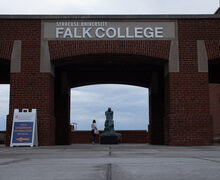Manufacturing controversy: Company’s use of 3-D printers to produce guns creates debate
Micah Benson | Art Director
The technology that allows the manufacturing of items such as human tissue, cartilage and pens, all in a single room, is creating controversy.
The concept, called three-dimensional printing, may revolutionize manufacturing processes. Three-dimensional printers are mainly being used in the commercial realm, but nonprofit Defense Distributed is looking to introduce another application: gun printing.
Defense Distributed, a pro-gun organization, is currently producing firearm parts and magazines using 3-D printing. The blueprints for these parts are posted online for the public to download. The website’s popularity has catapulted recently, boasting 50,000 blueprint downloads in the last two weeks, according to a March 11 ComputerWorld article.
A court would likely uphold the legality of 3-D gun printing, said Thomas Keck, associate professor of political science at the Maxwell School of Citizenship and Public Affairs.
“The Supreme Court never took the Second Amendment seriously until 2008, when individual rights were affirmed,” Keck said. “A lot of litigation will be needed but it is the kind of thing that the court would likely uphold, even though an actual decision on that topic is a long way off.”
New York Rep. Steve Israel is co-sponsoring a bill demanding a renewal of the Undetectable Firearms Act. If passed, the bill would ban the purchase of non-metal firearms undetectable by a traditional X-ray machine, such as guns manufactured by 3-D printing, according to a Jan. 18 article published by Forbes Magazine.
Defense Distributed has also experienced challenges obtaining funding because of its controversial hosting of firearm blueprints. Crowd-funding website IndieGogo removed Defense Distributed’s account because it violated IndieGogo’s terms of service. In addition, Stratasys, a 3-D printer manufacturing company, repossessed a printer that was rented to Defense Distributed, according to Forbes.
There are other uses for 3-D printing besides guns. Technology like the MakerBot allows products to be scanned for their physical dimensions and replicated. Website Thingiverse allows consumers to buy everyday products, like phone cases or necklaces, printed from 3-D printers, according to Forbes.
Although 3-D printing may have significant benefits in the future, Andy Molloy, information technology consultant for the School of Architecture’s fabrication equipment, which includes a 3-D printer, said these printers are good for prototypes and testing products but are not designed for mass production.
“It takes about 20 hours just to print a four-inch model,” Molloy said. “In addition, cartridges are very expensive, and these may be prohibitive factors despite having access to the blueprints of weapons.”
Despite the debate about 3-D printing, the technology is still being developed, Molloy said.
“As the cost of these high-tech printers decreases,” he said, “the three-dimensional printing technology is still in its early years, and it is difficult to forecast where we will be three years from now.”
Published on March 18, 2013 at 11:48 pm
Contact Jared: [email protected]




